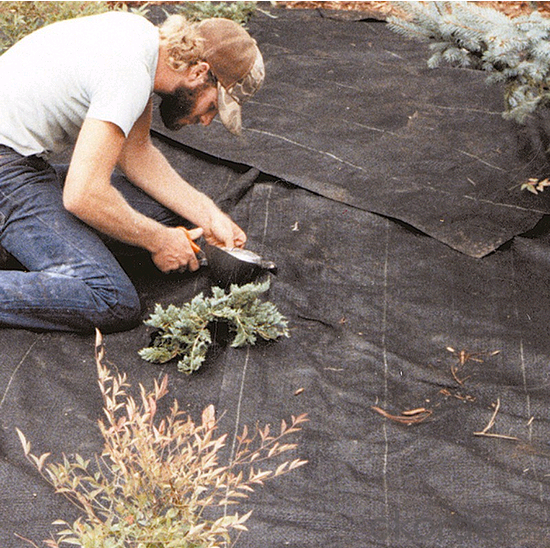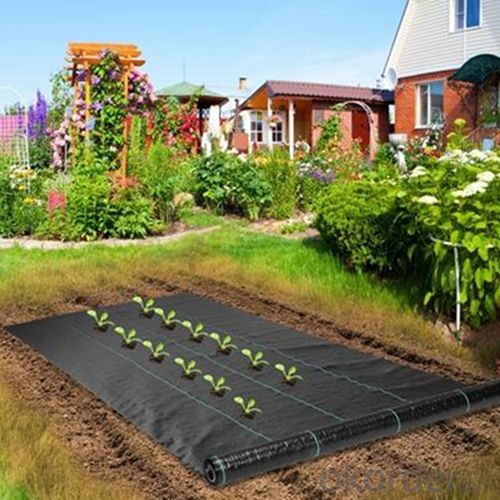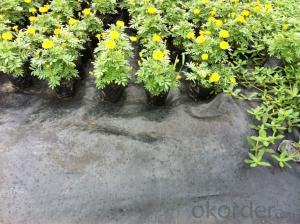Hersteller Geotextil Recycled Material PP Woven Weed Control Mat, PP Woven Weed Barrier Fabric
- Loading Port:
- Qingdao
- Payment Terms:
- TT or LC
- Min Order Qty:
- 10000 m²
- Supply Capability:
- 500000 m²/month
OKorder Service Pledge
OKorder Financial Service
You Might Also Like
Product Description
The weed control mat is made of environmentally friendly raw materials, pp woven fabric. It used to prevent the growth of weed,
without the use of potentially dangerous chemical sprays or labor intensive hoeing. Once installed, weed mat will continue providing
protection for years without maintenance.
They are permeable fabrics, which allow air, water and nutrients to pass through, and designed to block out the sun to reduce
photosynthesis and stop weed growth.
Specification
Item | Ground Cover / Weed Control Mat |
Material | 100% Polypropylene,with or without uv |
Aniti-UV Rate | can be customized(1%---4%) |
Width | 600 mm ~2400mm (max 2.4m, can be cut into any size) |
Length | 50M, 100M, 200M, as per request |
Weight | 90gsm ~ 100gsm, as per request |
Mesh Type | Square & sesame |
Color | Black, as per request |
Roll Diameter | 1.1 meter |
Loading Qty. | 5-6 Tons Per 20' fFT Pack in rolls with card tube in center and be wraped in PE or as customer need. |
Delivery | 15-20 Day Per 20' GP |
Features
1. Weed suppressant and drainage control landscaping fabric
2. Easy to use, Environmentally friendly
3. Allows water, air and nutrients through, suppressing weeds without the use of chemicals
4. Reduces the level of watering required due to the slower rate of water evaporation
Application
1. Excellent Weed Control
2. Moisture, fertilizers, air reach plants to allow for healthy soil
3. Good water and air permeability
4. Exceptional toughness and strength
5. Durable, tear-resistant; won't rot or mildew
6. Lightweight, easy to install, follows natural ground contours
7. Ideal for use in landscaped beds, under decks and walkways.
Packaging & Delivery
| Packaging Details: | Packed In Roll Or In Bales Or Cartons Or According To Customers Requirement |
| Delivery Detail: | 20 Days After Order Confirmed |







- Q: What are the long-term performance expectations for geotextile installations?
- The long-term performance expectations for geotextile installations are generally high. Geotextiles are designed to provide durable and effective solutions for various applications such as soil stabilization, erosion control, and drainage systems. With proper installation and maintenance, geotextiles can typically last for decades, providing long-lasting functionality and performance. However, specific performance expectations may vary depending on factors such as the type of geotextile, site conditions, and the intended application.
- Q: Geotextile detection sampling, how many meters
- Two meters by two meters! Geotextile manufacturers to answer!
- Q: How do geotextiles help in soil reinforcement?
- Geotextiles help in soil reinforcement by providing a strong and stable base for the soil. They act as a barrier between the soil and other materials, preventing erosion and maintaining the integrity of the soil structure. Additionally, geotextiles distribute the load evenly across the soil, reducing the risk of settlement and increasing the overall stability of the area.
- Q: Can the nonwoven geotextile be used to hold the soil
- Yes, the soil is not lost on the line, ground watering, if the balcony need to consider good health problems. More vegetables on the issue of "pan rice race vegetables Q & A network
- Q: Can geotextiles be used in agricultural waste management systems?
- Yes, geotextiles can be used in agricultural waste management systems. Geotextiles are commonly used to control erosion, improve drainage, and provide filtration in various applications. In agricultural waste management, they can be utilized to line storage ponds, control the flow of water, and separate different layers of waste materials. Additionally, geotextiles can help in preventing nutrient leaching and protecting the surrounding environment from contamination.
- Q: How are geotextiles used in slope stabilization?
- Geotextiles are used in slope stabilization by providing reinforcement and erosion control. They are installed in layers or grids along the slope to increase its stability, prevent soil erosion, and promote vegetation growth. The geotextiles act as a barrier, preventing the movement of soil particles while still allowing water to drain through. This helps to retain the soil and prevent it from sliding or eroding, ultimately stabilizing the slope and protecting it from further damage.
- Q: What are the specifications for geotextiles in green roof applications?
- Geotextiles used in green roof applications typically have specific specifications such as high tensile strength to withstand the weight of the vegetation and soil, excellent water permeability to allow efficient drainage, UV resistance to withstand prolonged exposure to sunlight, and appropriate thickness to provide adequate protection for the underlying layers of the green roof system.
- Q: What is the meaning of geotextile anchoring?
- Geotextile anchorage: is the geotextile in the construction of civil engineering construction in the slope of the fixed, to prevent the geotextile movement.
- Q: JTGF80 / 1-2004 "standard" 4.5 Geosynthetics in the treatment of the measured items in the "anchoring length", in the construction design diagram, the provisions of the value of the allowable deviation should be how to implement? Question added: Sorry! I missed a few words. When the construction design is not indicated, the specified value, the allowable deviation value should be implemented? JTGF80 / 1-2004 "standard only write to meet the design, construction requirements. I did not say that the design of the length of the anchorage is how much, can not find the construction technical specifications. So I do not know the provisions of the value of how to allow deviation? More
- Specifically not less than the specified value, does not exceed the allowable deviation. This is the so-called construction by specification! You refer to JTG assessment standard -2004 is correct! I have the data to let you refer to the next / geogrid and geotextile landscape is greater than or equal to 50cm, vertical is greater than or equal to 150com
- Q: What are the environmental considerations of geotextiles?
- Geotextiles have several environmental considerations, including their potential to release microplastics into the environment, their impact on soil and water quality, and their potential for improper disposal. Additionally, the production and manufacturing processes of geotextiles may contribute to carbon emissions and energy consumption, further affecting the environment. Therefore, proper usage, disposal, and monitoring of geotextiles are essential to minimize their environmental impact.
Send your message to us
Hersteller Geotextil Recycled Material PP Woven Weed Control Mat, PP Woven Weed Barrier Fabric
- Loading Port:
- Qingdao
- Payment Terms:
- TT or LC
- Min Order Qty:
- 10000 m²
- Supply Capability:
- 500000 m²/month
OKorder Service Pledge
OKorder Financial Service
Similar products
Hot products
Hot Searches
Related keywords




































